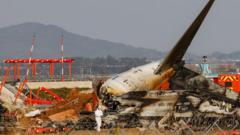In a public update via social media platform X, Air India confirmed that the cutback on international flights, primarily affecting its wide-body jets used for long-haul travel, is designed to enhance operational stability and improve passenger experience. This decision follows a directive from Indian authorities aimed at enforcing better operational practices amid growing safety concerns.
Since the crash, Air India's operations have faced severe disruptions, exacerbated by extended flight routes due to airspace closures linked to regional conflicts, including tensions between Iran and Israel. The Directorate General of Civil Aviation (DGCA) conducted inspections of the airline's fleet and reported finding no major safety concerns related to the existing fleet of 33 Dreamliners. Nevertheless, issues regarding maintenance and the need for improved coordination across various operational departments were highlighted.
To date, 26 aircraft have been cleared for continued operations, and the DGCA has advised the airline to enhance its internal communication systems to facilitate better real-time updates to passengers regarding potential plane defects and service changes. With a fleet size of 128, Air India operates roughly 1,000 flights each day, connecting numerous international destinations, including a popular non-stop service from Delhi to New York.
The airline's recent measures aim to rebuild confidence among travelers while addressing the critical need for cooperative operational efficacy during this tumultuous period.
Since the crash, Air India's operations have faced severe disruptions, exacerbated by extended flight routes due to airspace closures linked to regional conflicts, including tensions between Iran and Israel. The Directorate General of Civil Aviation (DGCA) conducted inspections of the airline's fleet and reported finding no major safety concerns related to the existing fleet of 33 Dreamliners. Nevertheless, issues regarding maintenance and the need for improved coordination across various operational departments were highlighted.
To date, 26 aircraft have been cleared for continued operations, and the DGCA has advised the airline to enhance its internal communication systems to facilitate better real-time updates to passengers regarding potential plane defects and service changes. With a fleet size of 128, Air India operates roughly 1,000 flights each day, connecting numerous international destinations, including a popular non-stop service from Delhi to New York.
The airline's recent measures aim to rebuild confidence among travelers while addressing the critical need for cooperative operational efficacy during this tumultuous period.



















